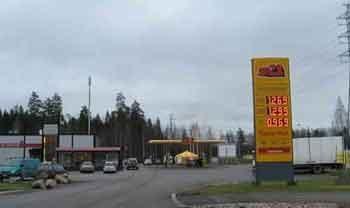News: Climate policy and transportation: Aspects of biofuels development in Finland

November 2009
Jyrki Sitolahti
Climate policy in Finland as a part of European Union consists of broad number of means. At first, the idea of sustainable development calls for energy saving. In the long run, the goal of the Finnish climate and energy strategy is to stop the growth of energy use and then slowly to diminish it. Plans for energy saving consist of broad strategies in different areas of society from economic life to private consumption. A few of the current Finnish strategies include applying new passenger car technology into use which calls for measures in car taxing, new energy regulations in constructing new buildings and repairing old ones, as well as new demands in the energy efficiency in the devices we produce.
In the European Union the climate is being protected with emission trading. In Finland this primarily covers industries like the mineral industry, production of pulp and paper, oil refinery, production of metals, services and production of heat and power. Sectors which are left outside of emission trading are agriculture, housing, waste service and transportation. In the European Union the use of renewable energy is being encouraged and according to the new directive the aim in Finland is to have 38% of all energy use be from renewable sources by the year 2020. In the transportation sector the general goal is 10%. Like other EU-countries Finland has agreed to diminish emissions in transportation sector which currently accounts for 18% of all carbon dioxide discharges in the country.
The solution to the challenge to reduce emissions is threefold through the use of technological innovations, by increasing biofuel use and finally by directing consumer behaviour. In Finland about quarters of the greenhouse gas (GHG) emissions from transportation sector originate in urban areas. In one example, the city of Järvenpää in the southern Finnish province of Uusimaa, the urban share of all GHG emissions is over 50%. Thus drivers’ behaviour in using a vehicle and the choice how to move from one place to another are also important factors in reducing emissions.
According to current legislation in Finland the share of biofuels must be 4% of all available fuels. The aim further from the year 2010 on is 5.75%. From renewable energy sources bioethanol is the easiest to use in transportation. Ethanol as a motor fuel is not a new innovation, its possibilities for use has been thought in the 1970’s and 1980’s as a consequence of oil crisis. In the 2000’s the lowering of carbon dioxide emissions has been a crucial factor in bioethanol use. Finland is one of the leading countries in developing both biodiesel and bioethanol. In 2006 the Finnish service station chain ST1 began to produce bioethanol with the help of VTT, Technical Research Centre of Finland. The optimization of the fuel also for the winter conditions is ensured with special abilities of VTT in fuels and vehicles. ST1’s Refuel which is sold as RE85 was planned to consist not only 15% of ordinary gasoline. Different components are selected carefully to ensure the ability of mixture to start engine also in cold weather. The optimal mixing proportion of components in bioethanol is tested carefully in VTT. The vehicles that use bioethanol as fuel are called flexi-fuel cars.
Biological waste from food industry and in the future biowaste from households and shops will be used as raw material for ST1’s bioethanol. The European Unions’s legislation for refuse supports using this kind of waste for energy. According to the legislation people should at first avoid producing waste, secondly refuse should be recycled and then, the third best choice is to convert the waste to energy.
No longer should we leave refuse to be dumped, especially biological waste. Untreated biowaste causes dangerous methane emissions to the atmosphere which can enhance the greenhouse effect. So, producing bioethanol from biological waste is not only good for the environment but also good for the pocket book.
Category:


































